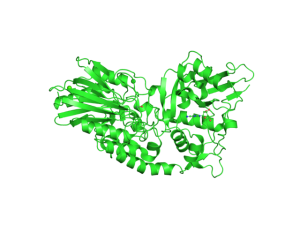
CD73 also known as 5´-Ectonucleotidase (NT5E) is a membrane-anchored protein that acts at the outer surface of the cell to convert AMP to adenosine and free phosphate. CD73 activity is associated with immunosuppression and prometastatic effects, including angiogenesis. CD73 is highly expressed on the surfaces of many types of cancer cells and other immunosuppressive cells (1). A recent study by Quezada and colleagues showed that the high concentration of adenosine produced by the CD73-catalyzed reaction on glioblastoma multiforme cells, which are characterized by extreme chemoresistance, triggered adenosine signaling and in turn, the multi-drug resistance (MDR) phenotype of these cells (2).
Because of the roles of adenosine in immunosuppression, angiogenesis and MDR phenotypes, CD73 (NT5E) is an attractive therapeutic target. However, the current methods of assaying for the ectonucleotidase activity, HPLC and a malachite green assay, are cumbersome and not suited to high-throughput screening. The HPLC assay is expensive and difficult to automate and miniaturize (3). The malachite green assay is sensitive to phosphate found in media, buffers and other solutions used in the compound-screening environment.
To address the problem of developing a reliable high-throughput screening assay for CD73, Sachsenmeier and colleagues (3) looked to a luminescent ATP-detection reagent.
They used the CellTiter-Glo® Luminescent Cell Viability Assay, which uses the luciferin/luciferase reaction to detect the presence of ATP. The luciferase reaction in the assay is inhibited by AMP. Adding the CD73 enzyme to the reaction degrades the AMP, and relieves the inhibition, producing light.
The authors determined the optimal ATP concentration for sensitivity of the CellTiter-Glo® Assay to AMP and the optimal molar ratio of AMP to ATP as well. Serial dilutions of recombinant human CD73 were used to measure the ability of CD73 to relieve the AMP inhibition of the luciferase reaction. Next they titrated an anti-NT5E (CD73) antibody to see if a known inhibitor of CD73 activity could maintain the luciferase reaction inhibition.
The authors conclude that because their assay did detect specific enzyme inhibition by the anti-NT5E antibody within a phage supernatant matrix, the assay is sensitive enough to detect other inhibitory antibodies in crude preparations. Reported Z´ factor values for the assay suggested low variability and a reliable assay.
The adaptation of the CellTiter-Glo® Assay for screening of CD73 (NT5E) activity represents an opportunity for high-throughput screening of CD73 activity and inhibitors that previously used methods did not. However, it may now possible to screen for the production of the AMP metabolite directly using the AMP-Glo™ Assay, which is a luminescent assay also amenable to high-throughput formats. Using either tool, researchers will be able to investigate CD73 compounds that inhibit its activity more thoroughly, perhaps finding some that will enhance the ability of other chemotherapeutic agents to successfully target tumors.
Literature Cited
- Sorrentino, R., Pinto, A. and Morello, S. (2013) The adenosinergic system in cancer OncoImmunology 2, e22448
- Quezada, C. et al. (2013) 5´-ectonucleotidease mediates multiple-drug resistance in glioblastoma multiforme cells. J. Cell. Physiol. 228, 602–8.
- Scahsenmeier, K.F. et al. (2012) Development of a novel ectonucleotidase assay suitable for high-througput screening. J. Biomol. Scr. 17, 993–8.
Michele Arduengo
Latest posts by Michele Arduengo (see all)
- The Casual Catalyst: Science Conversations and Cafes - July 18, 2024
- Cancer Moonshot: Solving Tough Problems - May 28, 2024
- Automated Sampling and Detection of ToBRFV: An Emerging Tomato Virus - April 25, 2024
